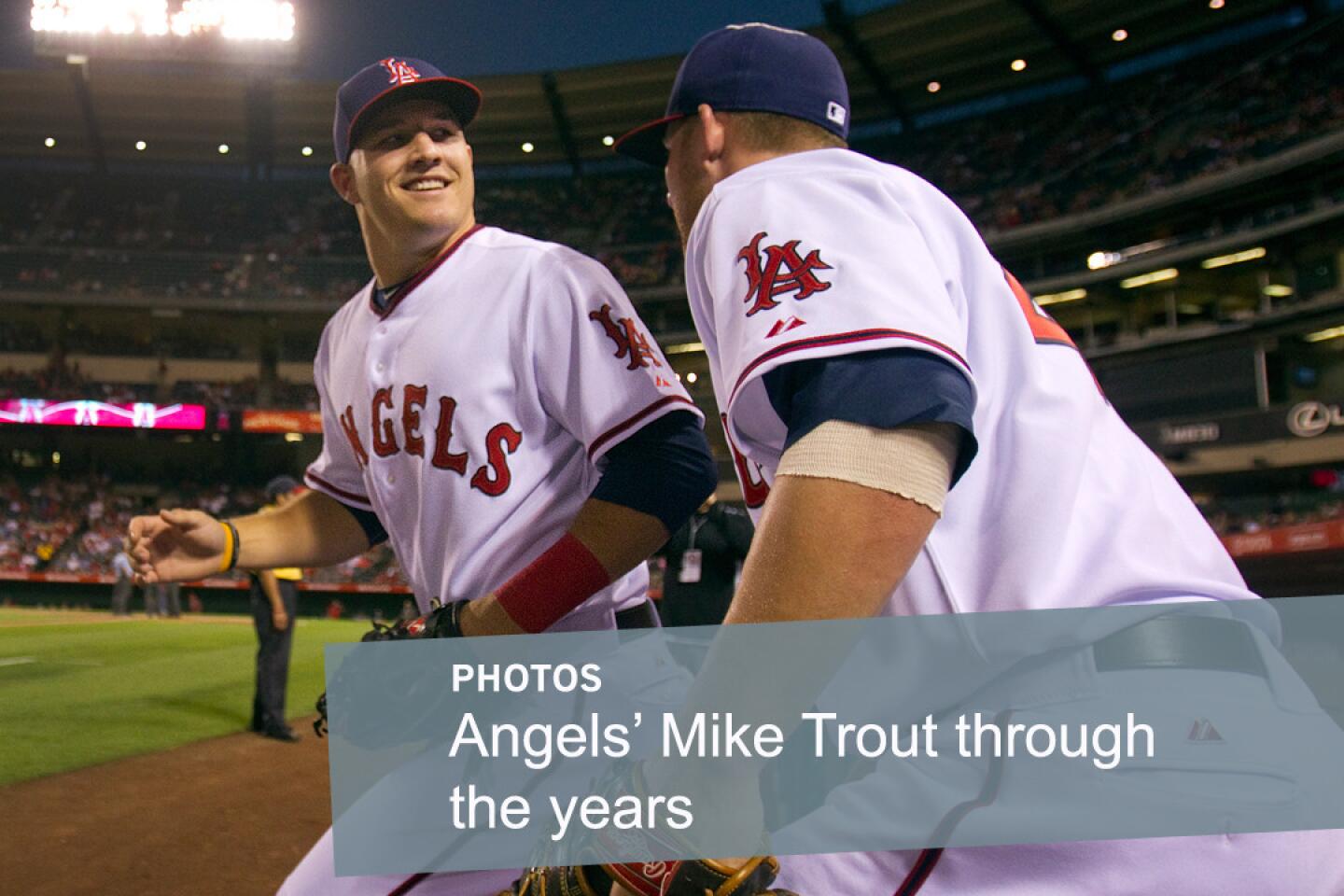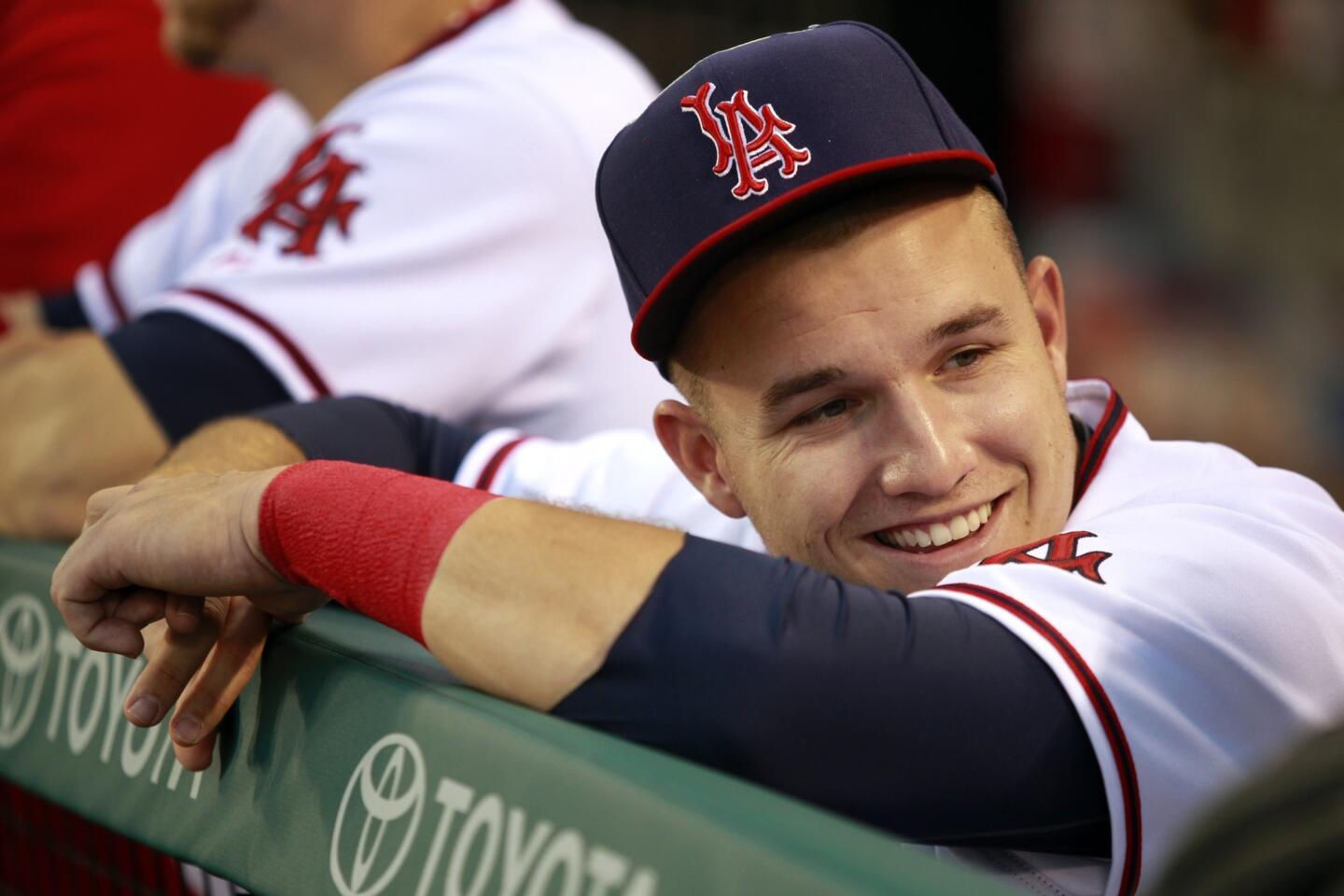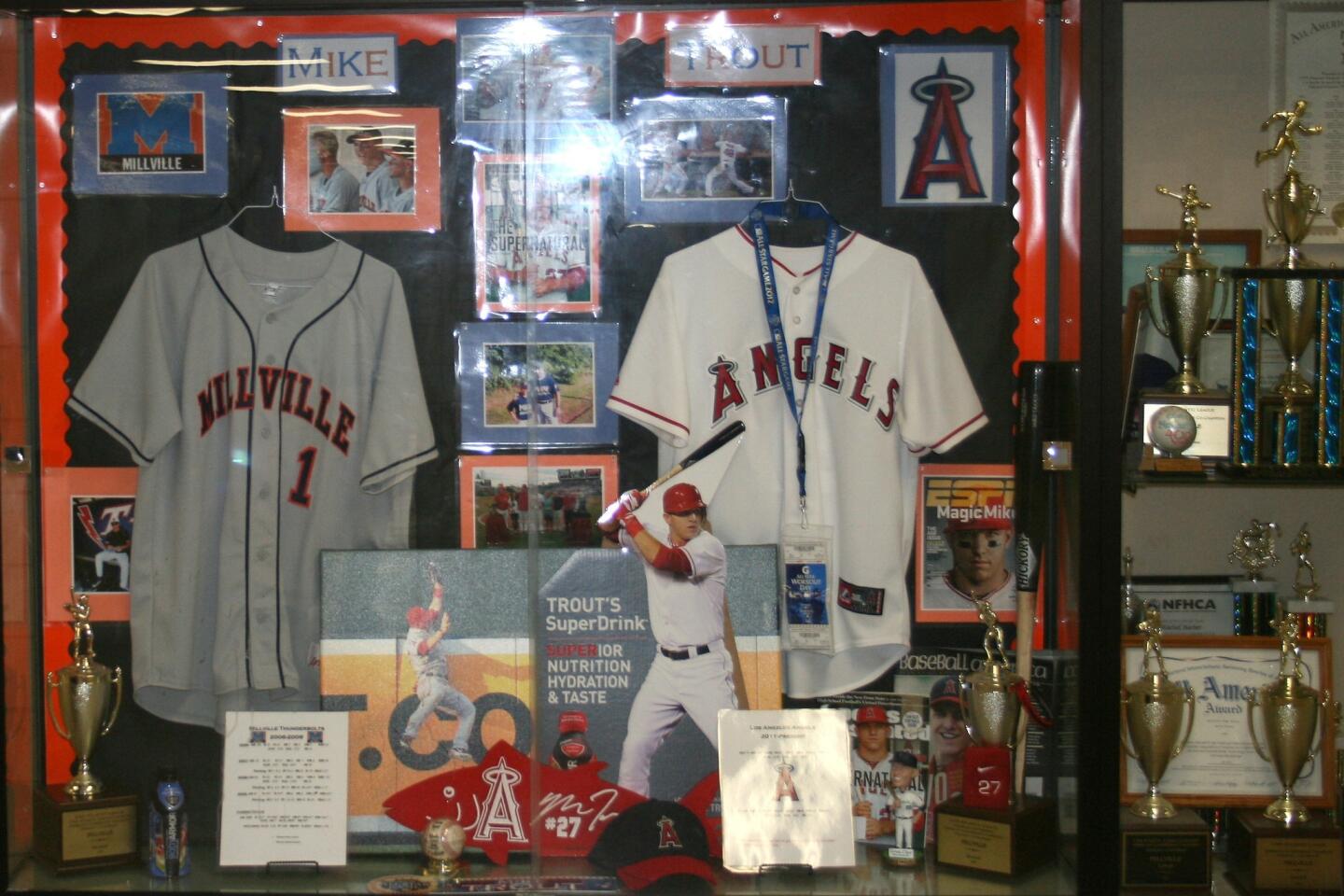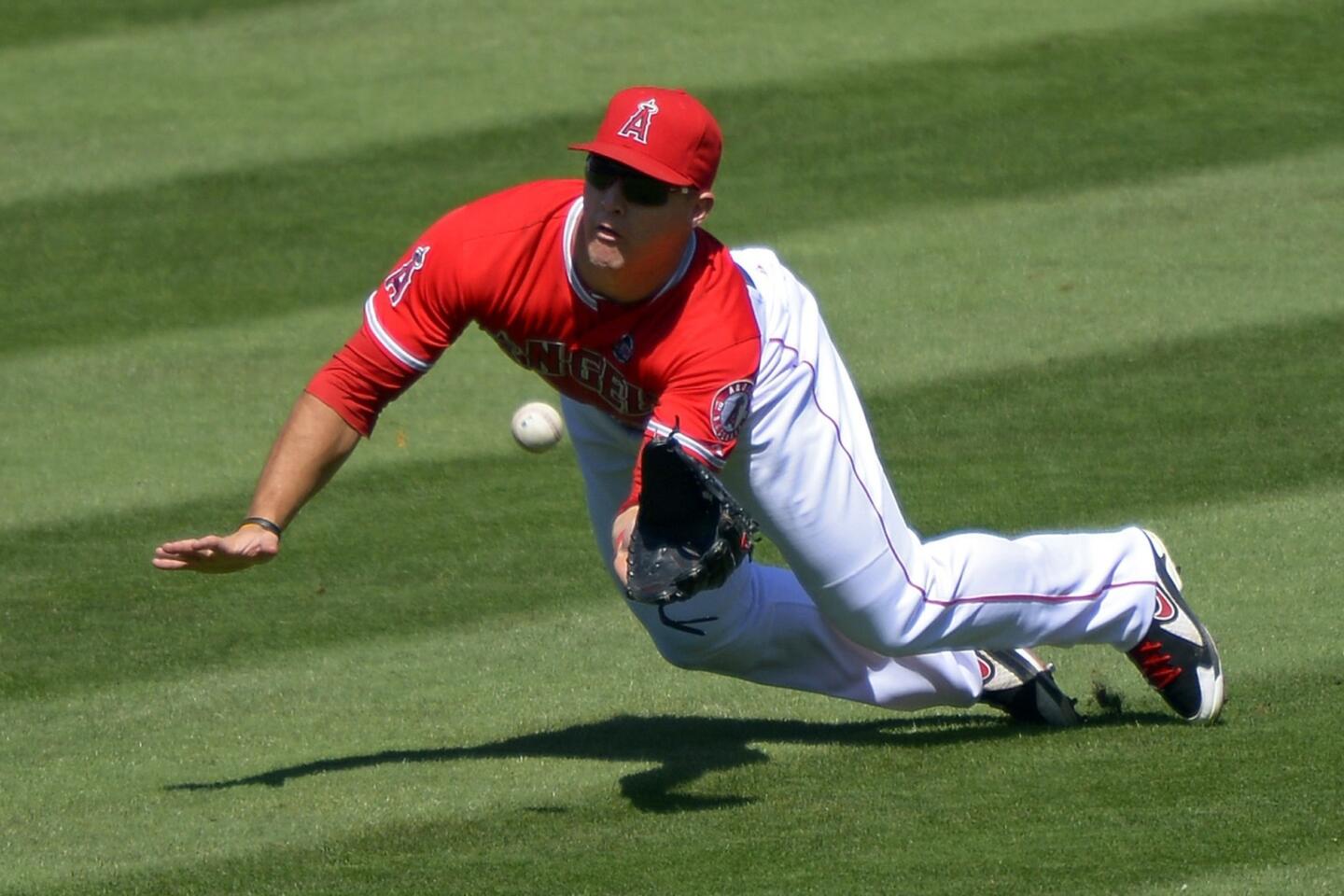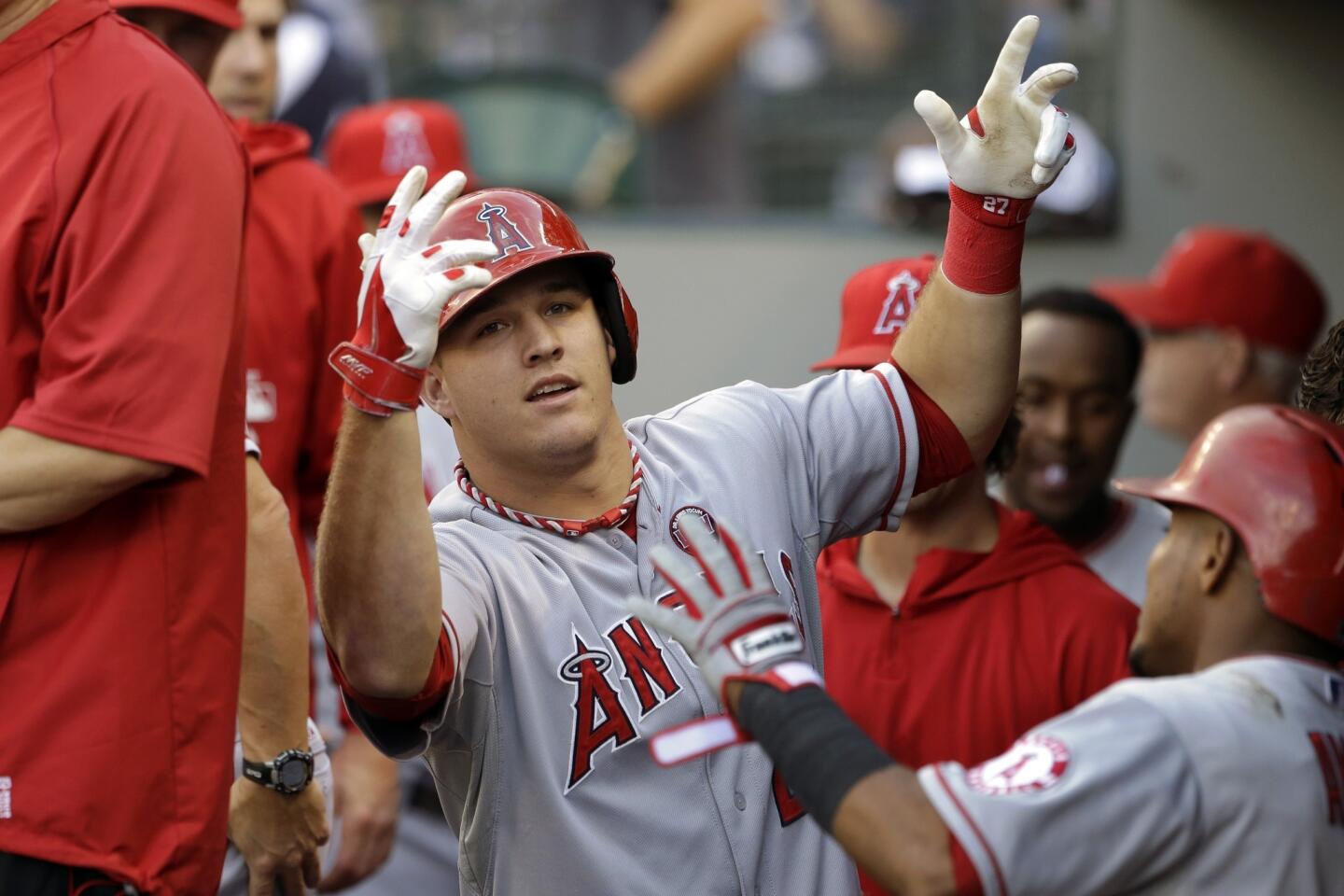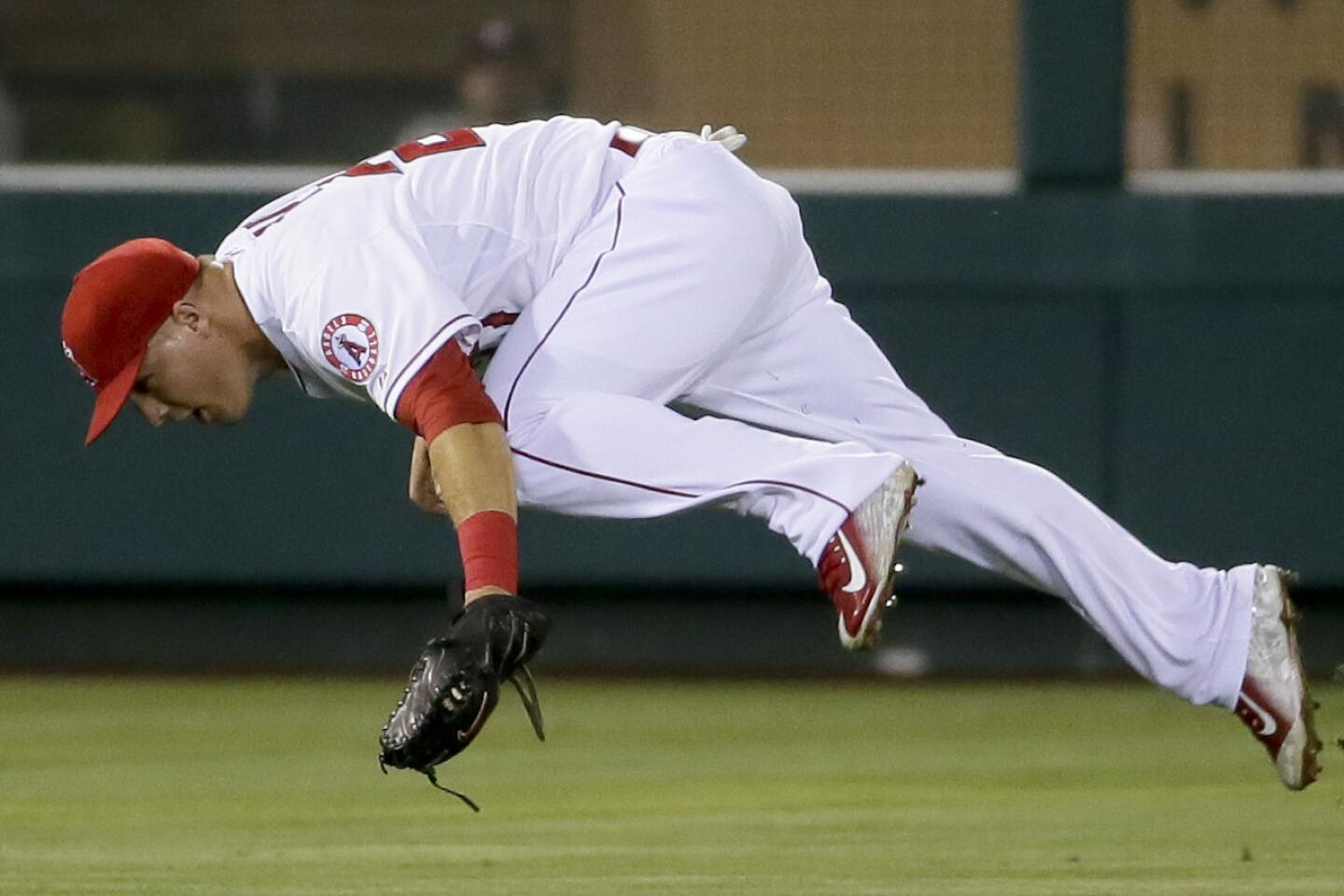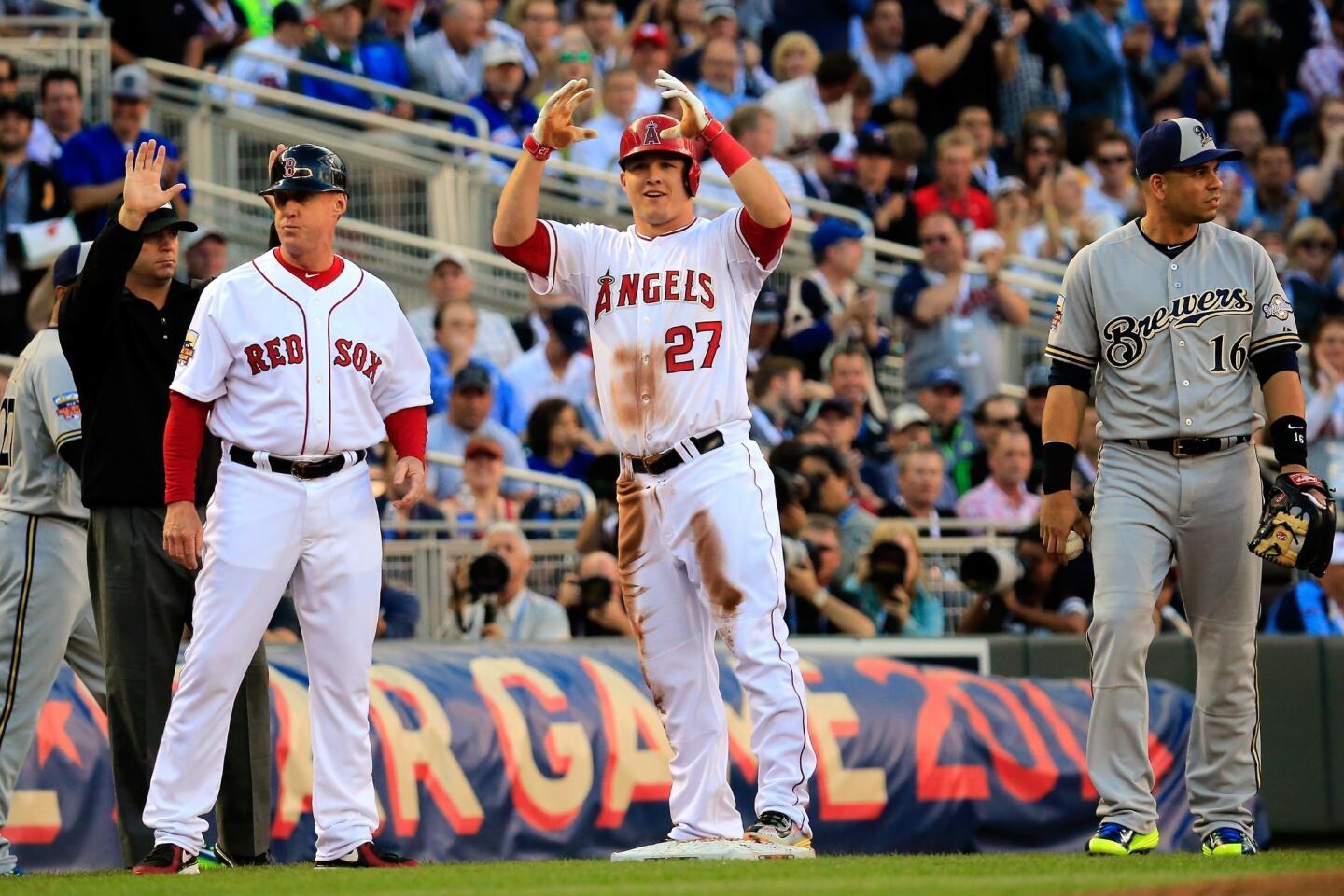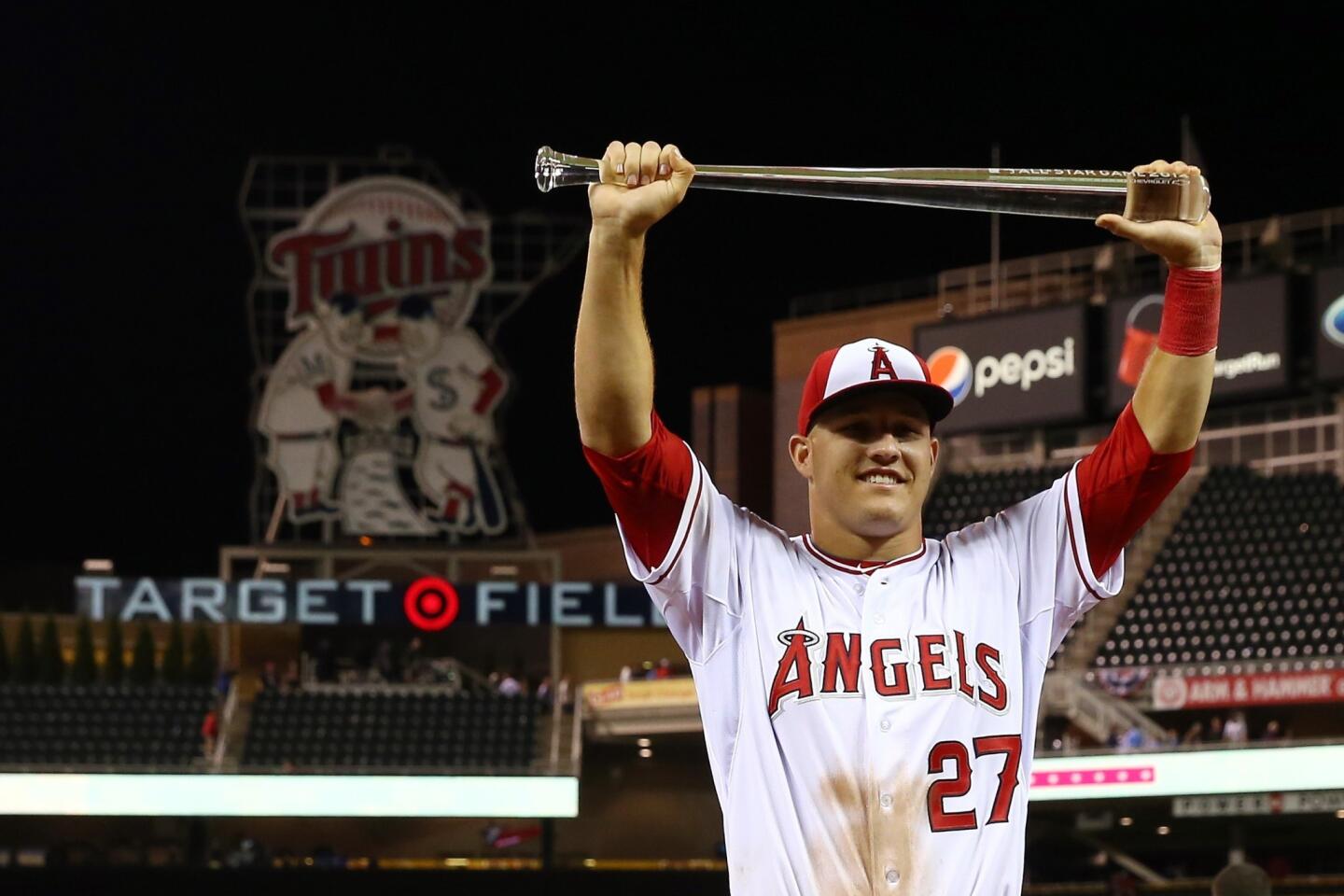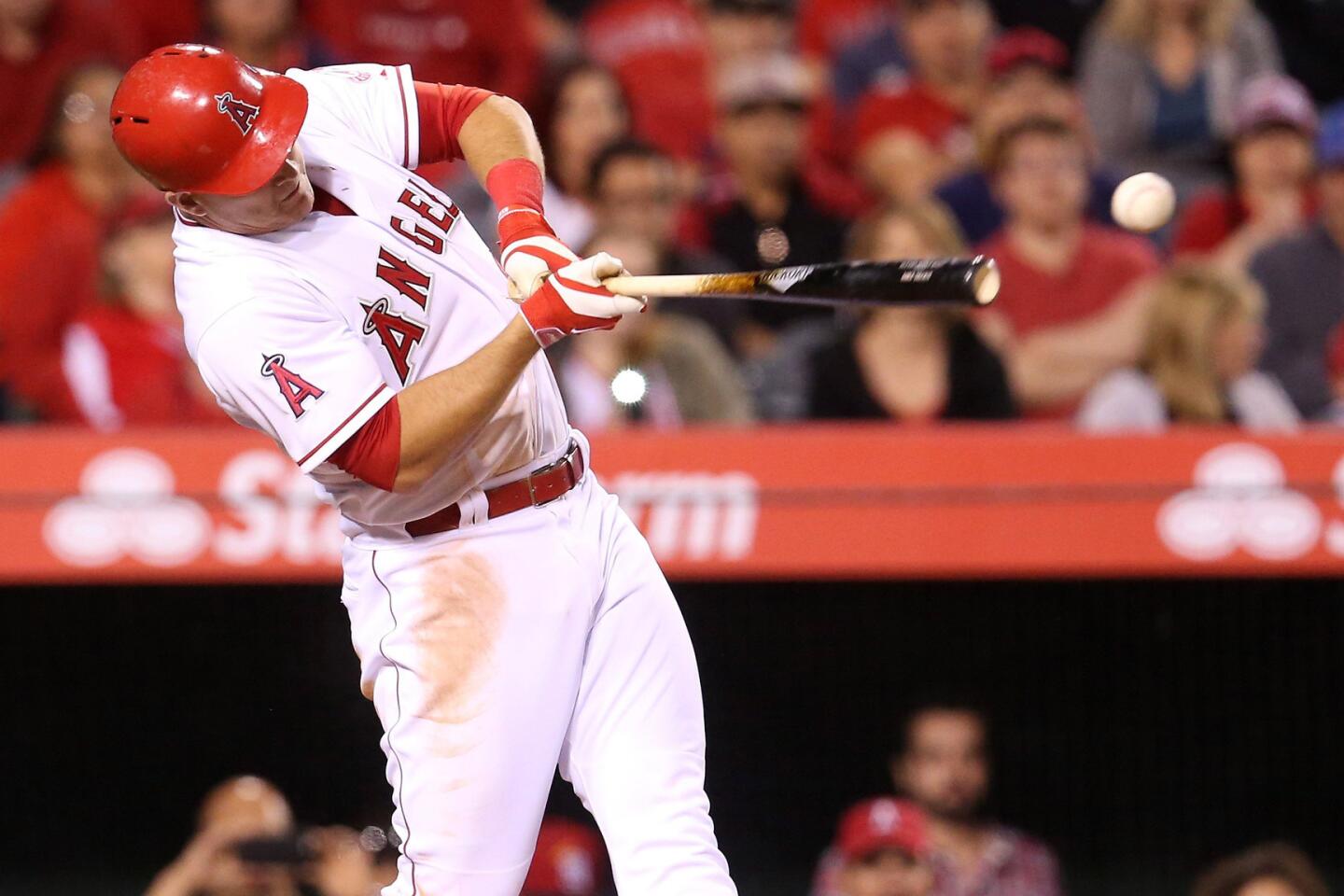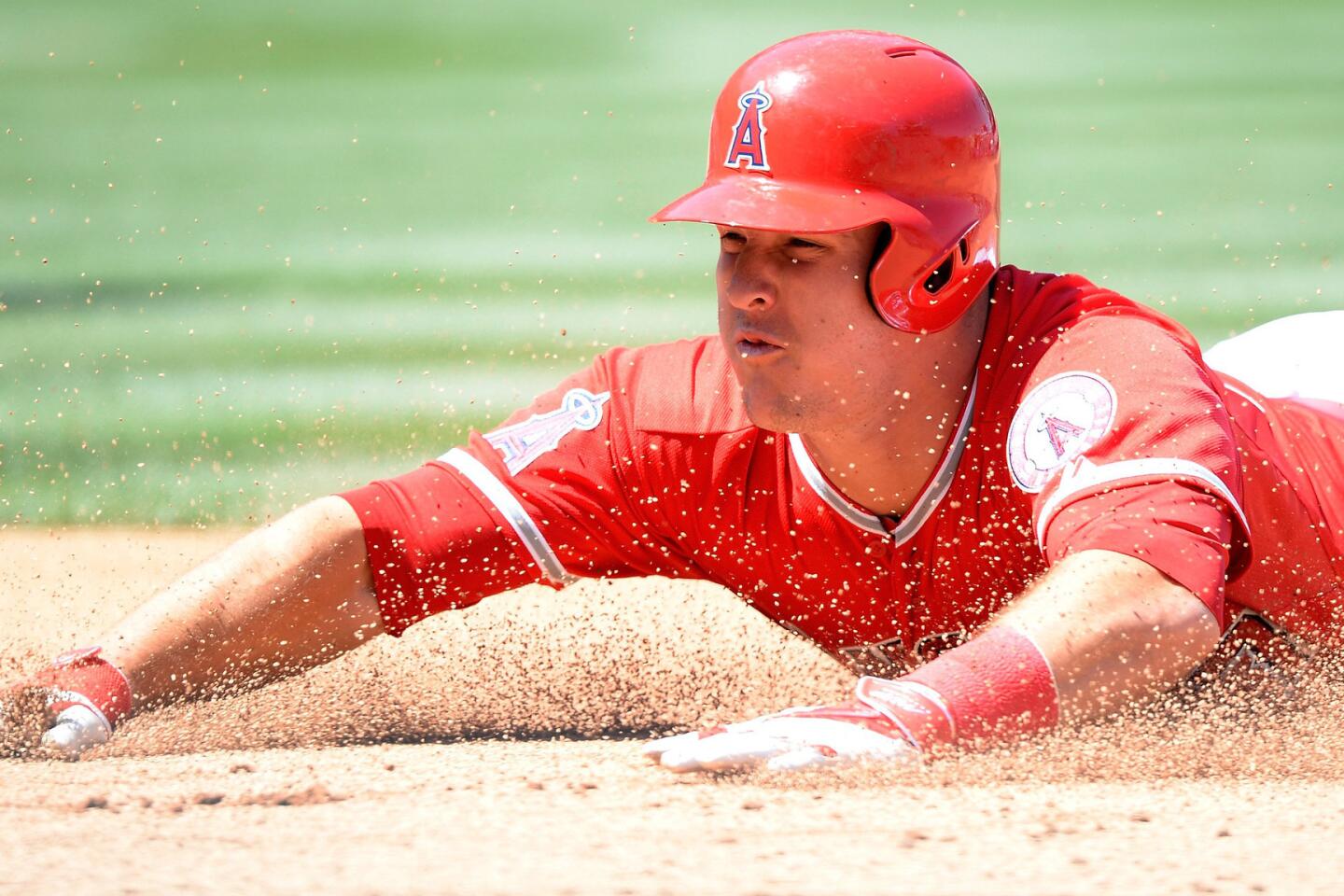Great Read: Angels’ Mike Trout: from can’t-miss kid to likely AL MVP in five years
- Share via
On a July afternoon five years ago, the possibility of Mike Trout became quite apparent to the Angels manager.
Before Trout’s $144.5-million contract, before the custom Nike cleats bearing the colors of a rainbow trout that he wore in the All-Star game this year, before the on-field exploits that attached a sense of awe to each mention of his name, the 17-year-old prospect smacked pitch after pitch over the right-field wall at Angel Stadium during a workout.
“We couldn’t believe it,” Manager Mike Scioscia said. “We kept saying, ‘Wait a minute. How old are you? That’s incredible.’ I said, ‘Do you do that in a game?’”
Those disbelieving glimpses of the kid from Millville, N.J., only hinted at what awaited.
After finishing as the runner-up for the American League’s most valuable player award in each of the last two seasons, the Angels centerfielder is poised to claim the prize Thursday.
So great is the gulf between Trout, 23, and the rest of the league’s position players that the award is practically a foregone conclusion despite a season in which he experienced precipitous declines in multiple offensive categories.
“He’s bigger, he’s faster, he’s stronger and he works just as hard as everybody else,” Angels catcher Chris Iannetta said. “And he has just the right amount of confidence and poise. Some people just got it. He’s got it.”
It’s easy to forget that he started the season as the AL’s fourth-youngest player.
Trout’s rare collection of skills is more frequently found in video game creations than real life. He can hit for power and a high batting average, make strong throws after running down balls hit into the gap, and create havoc on the base paths with his speed — the five tools coveted in baseball.
“As a pitcher, you can jam him, break his bat, think you have an out, next thing you know he’s busting his tail to first base, beats it out, then he steals second and you have a runner in scoring position,” Oakland Athletics reliever Sean Doolittle said. “There’s just so many different ways he can beat you.”
::
Trout’s frame — 6-foot-3, 230 pounds — resembles that of an NFL linebacker, but he runs like one of the white tail deer he hunts in New Jersey during the offseason.
After Trout reached base on an infield hit against the Dodgers in August, Hall of Fame broadcaster Vin Scully raved, “As big as he is, he has wings on his shoes!”
In July’s All-Star game at Target Field in Minneapolis, for instance, Trout smashed a pitch off the right-field wall. He accelerated to 18.2 miles per hour halfway up the first-base line, MLB Advanced Media’s Statcast recorded, and reached a top speed of 20.9 miles per hour on what turned into a triple.
That’s the same speed clocked in the game by Dee Gordon, the Dodgers second baseman who is 50 pounds lighter than Trout and led Major League Baseball with 64 stolen bases.
Trout became the second-youngest player to capture the All-Star game’s MVP award and responded in his usual aw-shucks fashion.
“It’s special for me. Chills, goose bumps, you name it,” he said. “Everything was running through my body.”
With Trout, head-shaking feats are commonplace.
There’s the power that ripped a career-best 36 home runs in 2014, including one June swing that sent the baseball 489 feet until splashdown in the fountain at Kauffman Stadium in Kansas City.
The rest didn’t just sneak over outfield walls. They averaged 410 feet, according to ESPN’s Home Run Tracker, almost 20 feet longer than MLB’s average home run.
Those balls come off his bat faster than they do for the typical player — 104.6 mph to 103.1 mph.
“You’re kind of taken aback by some of the things he does,” Angels reliever Joe Smith said.
Though pitchers usually strive to keep balls low to make it more difficult for batters to hit for distance, 22 of Trout’s home runs this season came on such pitches, the most in baseball.
“He’s as good a low ball hitter as I’ve ever seen and can power a pitch down and away on to the rocks in center field,” Kansas City Royals Manager Ned Yost said.
“You’ve got to pitch him aggressively,” Yost said, “but you’ve got to pitch him carefully, too, because he can pop a ball out of the ballpark at any time.”
Still, Trout’s strikeouts jumped from 136 in 2013 to 184 this season, the most in the AL, and his on-base percentage declined from .432 to .377.
::
Pitchers exploited Trout’s struggles with high fastballs.
During July, August and September, the rate of those pitches to him ranked among the top three in MLB. In August, for example, an analysis by Fangraphs showed that high fastballs accounted for 41.1% of the pitches thrown to Trout, the most of any player.
At the same time, 104 of Trout’s strikeouts came during that three-month stretch.
“That’s when I get in trouble, when I get too anxious and I chase,” Trout said.
What if those strikeouts declined?
“Shoot, you can’t have it all,” Doolittle said. “It’s not fair as it is right now. Geez, Louise.”
Before the Angels’ playoff series against the Royals, Trout discussed keeping the same swing that carried him through the season and not trying to hit home runs if they’re not needed.
“Sometimes, you hear the crowd going, you want to do so much, you get out of your approach,” Trout said after the series, where he managed one hit in 12 at-bats. “You try to do a little too much. … It’s something you have to work on.”
Trout’s intangible qualities draw as much praise from his teammates as his physical skills.
Scioscia recalled Trout’s first spring training when the youngster — who lasted until the 25th overall pick in the 2009 draft — appeared confident, aggressive and not intimidated by any situation.
That matched with the raw athletic ability he brought from high school that included a state-record 18 home runs as a senior.
Though regarded as baseball’s top prospect after batting .345 for three minor league teams to start his professional career, Trout struggled to a .220 average over 40 games in the big leagues and, at times, looked human.
His even-keeled response to strikeouts during his first taste of the big leagues in 2011 gave Scioscia more clues to the person wearing No. 27 on his back.
Failure didn’t seem to faze Trout.
He adjusted and recorded one of the great individual seasons in MLB history less than a year later.
“I think his makeup is what really stood out first before you saw the production start to come,” Scioscia said.
As that production transformed Trout into the AL’s likely next MVP, his competitiveness hasn’t ebbed. That extends off the field to clubhouse card games and playing the Clash of Clans video game with former Angels catcher Hank Conger.
“This dude, he refuses to lose,” Conger said. “His drive for everything, not only in baseball but in life, really shows what kind of player he is.”
Follow Nathan Fenno on Twitter @nathanfenno
Follow Mike DiGiovanna on Twitter @MikeDiGiovanna
More to Read
Go beyond the scoreboard
Get the latest on L.A.'s teams in the daily Sports Report newsletter.
You may occasionally receive promotional content from the Los Angeles Times.
